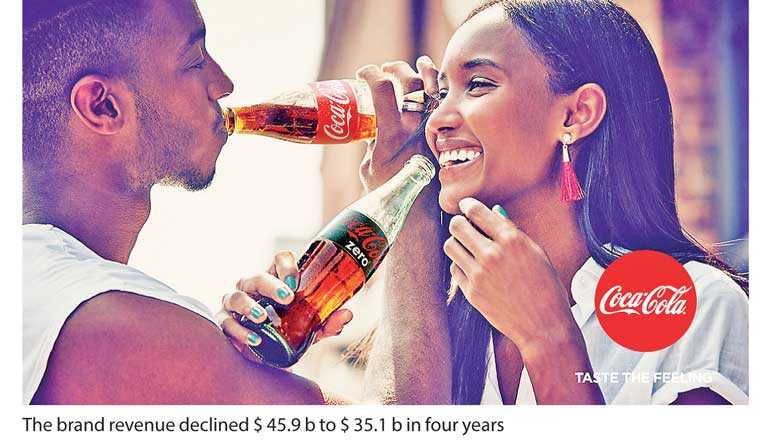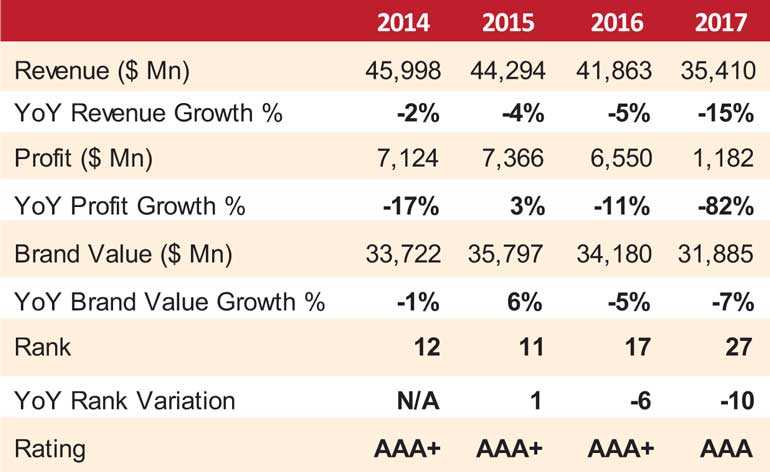Wednesday Dec 24, 2025
Wednesday Dec 24, 2025
Friday, 20 July 2018 00:00 - - {{hitsCtrl.values.hits}}


 We have heard the age old adage, if a brand is not in line to the trends of a customer, they will cease to exist over time. A classic example quoted in every university is Kodak. Now we see how another brand – Coca Cola – that is fondly remembered globally with good times and strong friendships following the same route unless some drastic action is taken on its road map.
We have heard the age old adage, if a brand is not in line to the trends of a customer, they will cease to exist over time. A classic example quoted in every university is Kodak. Now we see how another brand – Coca Cola – that is fondly remembered globally with good times and strong friendships following the same route unless some drastic action is taken on its road map.
A point to note is that the brand has survived for almost 132 years, which means that it is one of the most marketing-oriented companies that one can find in the global template.
Coca Cola story
The Coca Cola Company came into being in 1886 which means that the organisation has been serving the world for 132 years. The company’s operating model has been followed by many companies but they have not achieved the success that Coca Cola has achieved. The organisation provides the syrup and franchisees are stipulated to mix it with water and a combination raw material to produce the final drink which is incidentally available in every country in the world.
The two countries that are not selling the product are claimed to be Cuba and North Korea which will surely change given Trump’s linkage with the North Korean leader and the fast-changing trade agreement with Cuba.
It is interesting to see how the company has changed the communication campaign to suit the times in the last 132 years. Incidentally the company has used 46 slogans in its tenure on earth.
1886 – Delicious and Refreshing, 1907 – Good to the Last Drop, 1922 – Thirst Knows No Season, 1929 – The Pause That Refreshes, 1993 – Always Coca-Cola, 2006 – Coke Side of Life and in 2009 – Open Happiness. It will be interesting to see the awareness to top mind recall of the brand and its changing tag line.
Sri Lanka – unique
Whilst Coca Cola can be termed the world-leading beverage brand, Sri Lanka is one of the exceptional countries where it has been beaten by a local brand. Coca Cola has tried many strategies to lure the Sri Lankan consumer but Elephant House or popularly called ‘Aliya beema’ yet has the higher share of throat.
Best practice
In today’s world there is nothing called theory and practice, the logic being that theory has evolved from years of practice. The best practice conceptualised by Kotler and Keller that even business schools do not teach is that “the art and science of choosing target markets and getting, keeping, and growing customers through creating, delivering, and communicating superior customer value” is the way forward to keep a customer. If this is so the question is what went wrong with the Coca Cola and what are the lessons for corporate Sri Lanka?
Deep dive
If one does a deep dive on the results of Coca Cola it’s a mixed performance. The analysis is based on the financial data available for public consumption which I compiled when I was invited by my alma mater Harvard University for an evening meeting.
The top line has been declining continuously from 2014 onwards at single digit (2-5%) whilst last year (2017) it has nosedived by 15% to $35.4 billion, which means the company could not arrest this. Hence, if a deep dive is done with consumer research, one can find out what has been the loss due to usership declining and what has been the loss due to usage. Maybe a gains and loss analysis will tell the company to whom the loads is happening. In my view it might not be to a competitor Cola brand but maybe it is to the natural juices or it can be iced tea.
On the bottom line we see the decline stronger of 82% in 2017 which may be due to the strong course correction the company is investing in with new product development and strong marketing to protect the consumer base. What is strange is that even after four years the greatest company in the world with such a strong brand remains in the red on growth even though on absolute numbers it is registering a $ 1.1 billion profit.
Danger
Whilst the financial data can always be corrected with restructuring the operation, the danger to any business will be if the brand value is being eroded. Way back in 2014 the brand was valued at a commanding $33.7 billion but four years later the brand has hit a $31.8 billion which is a loss of 5.4%, will sure hurt the company balance sheet if good will is taken into account.
Confidence – Coca Cola
Whilst the overall financial health is not strong, an important point to note is how the company has kept the confidence level positive from the shareholders’ point of view. The 2017 share price has increased but the challenge will be how this can be maintained in the next two years. I guess time will tell.
Conclusion
A classic example from the world of business where a brand that has successfully cut across different cultures and religions, with ‘happiness brings people together,’ has today lost its flavouring to the changing consumer. It is been reported that in Japan, a test market, an alcoholic drink is in play but the final truth is that unless a brand is close to the customer even a powerful brand will lose the relationship with its customers.